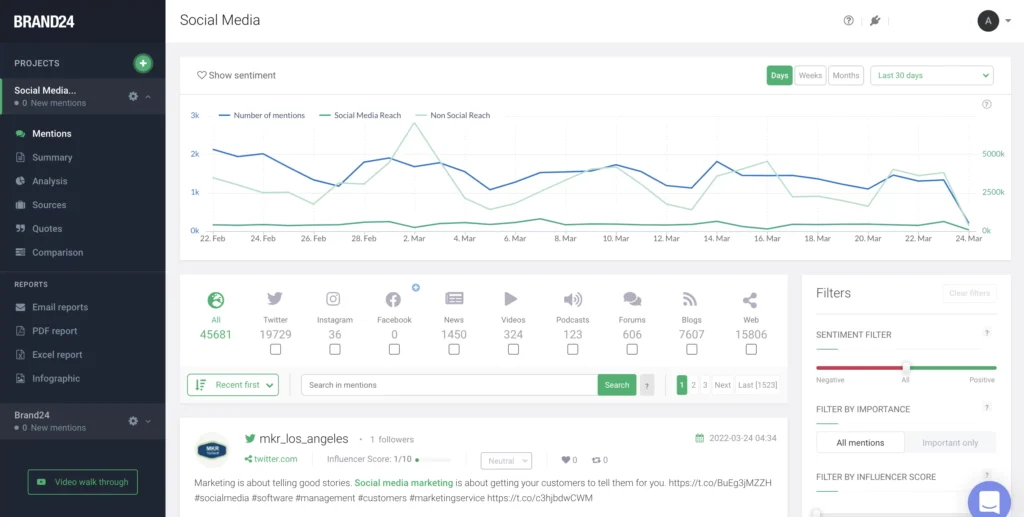Brand Audit Tools: Assessing and Improving Your Brand
A well-established and competitive brand is crucial for success in today's business world. Yet, it is vital to assess your brand’s performance regularly if you want it to reach your target audience effectively and engage with them. That’s where brand audit tools come in. A brand audit is a comprehensive analysis of the internal and external elements that make up your brand. It can help determine its current market position and identify potential areas for growth or enhancement.
By using brand audit tools properly, you can gain insight into actionable strategies that will improve things like customer satisfaction, overall business success and – of course – your brand's positioning.
Table of Contents
What exactly is a ‘brand audit’? Why do I need one?

A brand audit systematically examines internal and external factors to understand your current market position and highlight any areas requiring attention. It involves assessing various aspects of your organisation, including everything from values, culture, unique selling proposition (USP), visual identity, advertising efforts, website and social media presence through to customer perception.
It’s important because:
- It enables you to align your actual reputation with what you think it should be
- It helps you assess where you sit in terms of market share
- Allows identification of strengths and weaknesses
- Uncovers new opportunities
For example, Let’s say there’s a clothing company wanting to carry out an examination. By looking at its internal factors such as values or USP (unique selling proposition), this firm may realise it needs to redefine its messaging or target audience to better resonate with customers.
By examining external factors such as social media presence/website, they see opportunities to better engage consumers by enhancing online user experience/engagement strategies.
Conducting this kind of exercise would lead this clothing company to use insights gained to inform marketing strategies/practices, improve positioning/customer satisfaction, etc.
What are the critical components of a brand audit?
A brand audit evaluates internal and external factors contributing to a brand's identity and market position. This comprehensive analysis allows businesses to gain a holistic view of their brand performance and identify areas for improvement.
The critical components of a brand audit include:
- Internal Factors: This component involves assessing the brand's values, culture, unique selling proposition, and positioning within the organisation. By evaluating the brand's mission and vision, understanding its core values, and analysing internal communication strategies and employee engagement, businesses can ensure that their brand is aligned with their overall business objectives. For instance, a tech company conducting a brand audit may discover that its internal messaging is not effectively communicating its commitment to innovation. By refining its brand values and internal communication strategies, the company can align its employees' understanding of the brand and foster a culture of innovation that resonates with its target audience.
- External Factors: This component analyses the brand's visual identity, advertising efforts, website, social media presence, and customer perception. Businesses can ensure consistency and cohesiveness across all brand touchpoints by evaluating its visual elements, such as logo, colour palette, and typography. For example, a beauty brand conducting a brand audit may realise that its visual identity needs to convey its brand essence of natural and organic ingredients effectively. The beauty brand can create a more compelling and authentic image by refining its visual elements to align with its brand values.
- Competitive Analysis: A crucial aspect of a brand audit is conducting a competitive analysis to evaluate the brand's position within the competitive landscape. By analysing competitors' strategies, strengths, and weaknesses, businesses can gain insights into how they can differentiate themselves and gain a competitive advantage. For instance, a food delivery service conducting a brand audit may discover that its competitors offer various cuisine options. By identifying this gap, the food delivery service can expand its offerings to include a diverse range of cuisines, effectively positioning itself as a leader in the market.
- Customer Analysis: Understanding customer perceptions and preferences is vital for a brand audit. Businesses can gain insights into their opinions, needs, and expectations by gathering customer feedback through surveys, interviews, or social media listening. For example, a hospitality brand conducting a brand audit may find that its customers perceive it as lacking personalisation in its services. By gathering this feedback, the brand can implement personalised experiences to meet customer expectations and increase customer satisfaction.
By evaluating these key components, businesses can comprehensively understand their brand's performance and identify areas for improvement and growth.
Examples of popular brand audit tools and software

Several popular brand audit tools and software are available to assist businesses in conducting comprehensive brand audits. These tools provide valuable data and insights that can streamline the brand audit process and facilitate informed decision-making. Let's explore some examples:
- Brand24: Brand24 is a social media monitoring and analytics tool that allows businesses to track brand mentions, sentiment analysis, and customer feedback. By monitoring social media conversations, companies can understand how customers perceive their brand and identify areas for improvement. For example, a tech company can use Brand24 to monitor social media mentions of its brand and gain insights into customer sentiment towards its products. This data can help the company identify areas where it excels and needs to improve.
- SuperSide: SuperSide offers a brand audit template and framework to guide businesses through the brand audit process. The platform provides a structured approach and a comprehensive set of questions that companies can use to assess internal and external factors. For instance, a fashion retailer can use SuperSide's brand audit template to evaluate its visual identity, advertising efforts, and customer perception. This will help the retailer better understand its brand's strengths and weaknesses and guide its strategy for brand improvement.
- Mention: Mention is a brand monitoring tool that enables businesses to track brand mentions across various online platforms, monitor social media conversations, and analyse sentiment analysis. By keeping track of brand mentions, companies can gain insights into customer sentiment and identify opportunities for engagement and improvement. For example, a restaurant chain can use Mention to monitor online reviews and social media conversations about its brand. This will allow the chain to address negative feedback quickly and proactively engage with customers, improving its brand reputation and customer satisfaction.
These brand audit tools provide businesses with valuable data and insights that can inform their strategies for brand improvement, customer engagement, and overall business success.
How can brand audit tools be effectively utilised?

To effectively utilise brand audit tools, businesses should follow a systematic approach that maximises the benefits of the tools and ensures actionable insights. Here are the key steps to effectively utilise brand audit tools:
- Set Clear Objectives: Defining objectives and goals is crucial before starting the brand audit process. Determine what specific aspects of the brand you want to evaluate and improve. This will guide the entire brand audit process and ensure the collected data aligns with your objectives.
- Choose the Right Tools: Select brand audit tools that align with your objectives and requirements. Consider factors such as the scope of analysis, data gathering capabilities, ease of use, and compatibility with your existing systems. Choose tools that provide a comprehensive analysis of both internal and external factors. For example, a software company conducting a brand audit may choose devices such as Brand24 and Mention to monitor its social media presence and gather customer feedback. These tools will provide insights into customer sentiment and help the company identify areas for improvement in its brand communication strategies.
- Gather Comprehensive Data: Utilise the selected brand audit tools to gather data from various sources, including social media, customer feedback, website analytics, and competitor analysis. Ensure that the data collected covers all the critical components of a brand audit, such as internal factors, external factors, competitive analysis, and customer analysis. For instance, an e-commerce brand audit may use SuperSide's brand audit template to assess its visual identity and website performance. Simultaneously, it can use Brand24 to monitor customer sentiment on social media platforms and Mentions to track brand mentions and online reviews.
- Analyse and Interpret Data: Once the data is collected, analyse and interpret it to gain meaningful insights. Look for patterns, trends, and areas that require attention or improvement. Identify strengths, weaknesses, opportunities, and threats to your brand. For example, a travel agency can analyse customer feedback gathered through brand audit tools and identify that customers perceive its website as slow and challenging to navigate. This insight can inform the agency's decision to improve its website's user experience, ultimately enhancing its brand image.
- Develop Actionable Strategies: Based on the insights gained from the brand audit, develop actionable strategies to enhance brand positioning, improve marketing communications, and align offerings with customer expectations. Determine the specific actions that need to be taken to address the identified areas for improvement. For instance, a fitness brand conducting a brand audit may discover its messaging not effectively resonating with its target audience. As a result, the brand can develop a new marketing communications strategy that emphasises the unique benefits of its fitness programs and better aligns with its target audience's needs and aspirations.
- Implement and Monitor: Implement the strategies developed based on the brand audit insights and monitor their effectiveness. Continuously track and measure key performance indicators to ensure progress and make necessary adjustments. For example, a technology startup can implement a revised brand messaging strategy based on the insights gained from the brand audit. It can then monitor the impact of this new messaging through website analytics, social media engagement metrics, and customer feedback.
By effectively utilising brand audit tools, businesses can gain valuable insights, develop actionable strategies, and improve their brand positioning, marketing communications, and overall business performance.
What are the benefits of using brand audit tools?

Using brand audit tools provides several benefits for businesses, enabling them to make informed decisions and take proactive steps to enhance their brand:
- Improved Brand Awareness: Brand audit tools help businesses understand how customers perceive their brand and identify opportunities to enhance brand awareness and visibility. By monitoring brand mentions and sentiment analysis, companies can gauge the effectiveness of their brand communication strategies and make necessary adjustments. For example, a software company using Brand24 can track social media mentions of its brand and identify influential online users who can help increase brand awareness through positive word-of-mouth.
- Enhanced Marketing Communications: Businesses can improve their marketing communications strategies by analysing data gathered through brand audit tools. They can ensure that their messaging is consistent, resonates with their target audience, and effectively communicates their brand values and unique selling proposition. For instance, a fashion brand using SuperSide's brand audit template may discover that its current advertising efforts are not effectively conveying its brand essence. It can then refine its advertising campaigns to align with its brand values and better connect with its target audience.
- Guidelines for Brand Development: Brand audit tools provide valuable insights that can inform brand development strategies. By evaluating visual elements, brand messaging, and customer perception, businesses can create guidelines for brand development that ensure consistency and cohesiveness across all touchpoints. For example, a hospitality brand conducting a brand audit may identify inconsistencies in its visual identity across different locations. By establishing clear guidelines for visual elements, such as logo usage and colour palette, the brand can ensure a consistent brand experience for its customers.
- Increased Company Value: A strong and well-positioned brand increases the overall value of a company. Brand audit tools help identify areas for improvement, enabling businesses to enhance their brand equity and improve their company's value. For instance, a technology startup conducting a brand audit may discover that its competitors have a more recognisable brand identity. By identifying this gap, the startup can develop a brand strategy that strengthens its brand presence and increases its company's value in the eyes of investors and stakeholders.
- Insights on Brand Positioning: Brand audit tools allow businesses to assess their market position and identify opportunities for differentiation. Businesses can effectively position their brand in the competitive landscape by analysing competitors' strategies and understanding customer perceptions. For example, a beverage company conducting a brand audit may find that its customers perceive it as lacking in sustainability initiatives. By identifying this gap, the company can develop a sustainability strategy that aligns with customer expectations and positions it as an environmentally conscious brand.
- Increased Customer Satisfaction: By understanding customer perceptions and preferences through brand audit tools, businesses can tailor their offerings to meet customer expectations. This leads to increased customer satisfaction and loyalty, ultimately driving business growth. For instance, a retail brand using Mention to monitor online reviews may identify recurring customer complaints about customer service. The brand can enhance customer satisfaction and loyalty by addressing these issues and improving customer service.
In conclusion, brand audit tools are vital in assessing and improving a brand's performance. By effectively utilising these tools, businesses can gain valuable insights, develop actionable strategies, and enhance their brand positioning, customer satisfaction, and overall business success. Regular brand audits enable businesses to stay competitive in a rapidly evolving market and ensure their brand remains relevant and resonates with their target audience.
